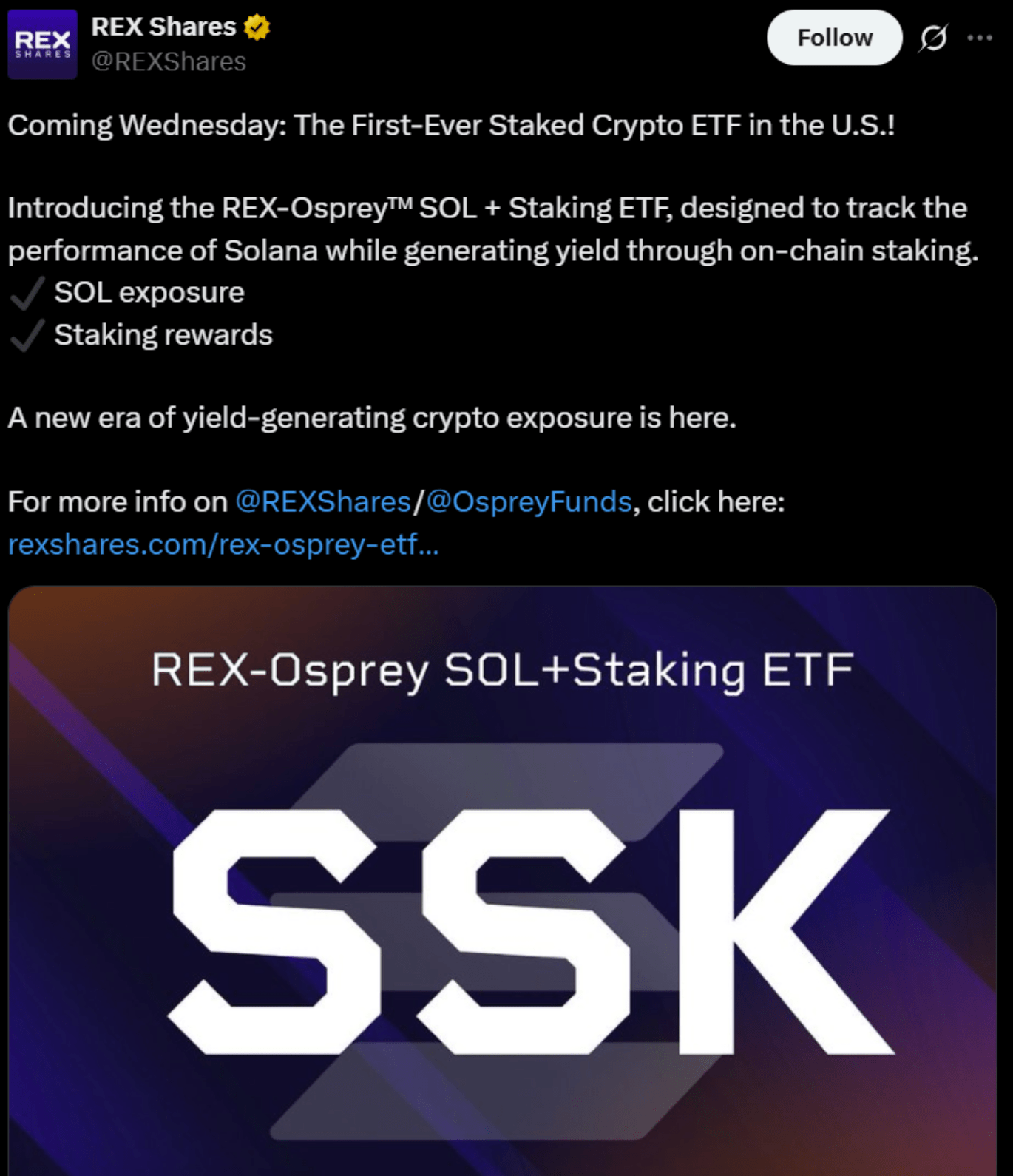Solana ETF products are redefining crypto investment strategies in 2025. Following Canada's pioneering launch of staking-enabled Solana ETFs and the recent U.S. regulatory greenlight for similar products. North American inflows have surged beyond $500 million within weeks. These regulated vehicles allow market participants to gain dual exposure to SOL's price movements and native staking rewards through traditional investment frameworks, establishing critical infrastructure connecting conventional finance with blockchain networks.
This analysis examines the mechanics of Solana staking ETFs, current regulatory milestones, operational structures of yield-generating ETFs, their ecosystem implications, projected returns, and addresses key investor inquiries.
What Is a Solana Staking ETF?
A Solana staking ETF is a next-generation exchange-traded fund providing direct exposure to Solana (SOL) while leveraging the blockchain’s Proof-of-Stake protocol for additional returns. By staking SOL with professional validators, the Solana staking ETF accrues network rewards, which are then distributed to shareholders after fees. This dual-value proposition—SOL price participation plus on-chain staking yield—is only available via this innovative Solana ETF vehicle.
Notably, investing in exchange-traded funds frees the investor from managing crypto wallets, validators, and even exchanges. The individual simply needs to buy the ETF from a brokerage account similar to a stock.
Progress of Solana ETF Approvals
In July 2025, the U.S. made headlines by approving the first Solana staking ETF, launched by REX Shares and Osprey Funds. This Solana ETF is the first in the U.S. to combine price tracking with Solana staking reward distributions, following Canada’s earlier lead with its spot and staking Solana ETF launches.
Source: X account
SEC Requests Updated Filings as Review of Solana ETFs Continues
In an update on July 7, the Securities and Exchange Commission asked prospective issuers of Solana-based ETFs to respond to comments and re-file amended S-1 documents before the end of July.
The SEC has also
invited public comments on whether the proposed rule to list and trade Solana ETF shares effectively prevents fraud and manipulation or raises new concerns. Interested parties can submit their views within a set comment period, with an opportunity for rebuttals to be filed afterward.
This step extends the review process and was expected by analysts following the ongoing evaluation of some crypto ETF applications.
Although the SEC has until October 10 to make a final decision regarding the Solana ETF proposal, current developments suggest that the evaluation may be completed earlier. The pace of this process may be influenced by recent events, particularly the automatic clearance of another Solana-linked fund under a separate legal structure.
The REX-Osprey SOL and Staking ETF, which operates under the Investment Company Act of 1940, became effective last week without objection from the SEC. This approval route differs from the process used for most crypto ETFs, including Fidelity’s, but it may have implications for how the SEC handles comparable products going forward. A source familiar with the situation said,
I think that the SEC has some pressure to approve these quicker than waiting all the way to October, especially with that Rex Shares product that got approved last week
Technical Requirements and Regulatory Engagement
The SEC has been closely examining Solana ETF applications as part of its wider review of crypto funds. In June, the agency requested that issuers update their S-1 filings to include more detailed information on important operational aspects.
This includes how staking rewards are handled and the mechanisms for creating and redeeming ETF shares through in-kind processes.
These details are critical to the commission’s evaluation, as they help determine whether the proposed structure aligns with existing investor protection standards.
James Seyffart, an ETF analyst at Bloomberg, indicated that the delay in Fidelity’s Solana ETF application was anticipated. He has previously predicted that ETFs based on Solana, XRP, and Dogecoin will likely receive approval later this year.
Seyffart noted that the SEC is still working on a broader framework for digital asset exchange-traded products, which is influencing the timing of these decisions.
How Does a Solana Staking ETF Work?
A Solana staking ETF collects investor funds and purchases SOL tokens, allocating these to professional validators within Solana’s Proof-of-Stake consensus model. By actively staking, these tokens help secure the network and participate in transaction consensus. For every epoch—about two days—staked SOL earns on-chain rewards that are delivered back to the ETF. After deducting management, custody, and operational fees, the Solana staking ETF distributes these rewards to shareholders as cash dividends or through NAV appreciation.
Unlike self-directed staking, where participants endure lock-ups and technical hurdles, investors in a Solana staking ETF benefit from immediate liquidity, transparent management, and simple exposure to the combined benefits of Solana price action and network rewards. This model has quickly become the gold standard for blockchain yield generation among institutional and individual investors.
Why Are Staking ETFs Important to the Solana Ecosystem?
The rise of Solana staking ETFs plays a critical technical role in strengthening the overall Solana network. By gathering large pools of SOL and distributing them across decentralized validators, these ETFs bolster the network’s security by increasing the economic resources protecting consensus. Greater stake amounts raise the barrier for any potential network attack, enhancing resistance to malicious actors and improving overall decentralization metrics.
Solana staking ETFs further promote optimal stake distribution, helping avoid validator centralization and increasing the network’s Nakamoto Coefficient—a key measure of blockchain decentralization. Institutional ETF managers use advanced monitoring and compliance practices to spread delegated stakes across hundreds of high-performance validators, supporting network health, uptime, and transaction throughput. These ongoing inflows from Solana staking ETF products also incentivize continuous innovation in validator infrastructure and DeFi dApp development, reinforcing Solana’s position as a blockchain leader.
A Closer Look at Solana’s Network and Capital Strength
While regulatory decisions are still pending, Solana is showing strong activity on-chain and drawing major investor interest.
Here’s why Solana’s momentum is hard to ignore:
-
Over 14.6 million active addresses on Solana in a single day show massive user engagement.
-
Solana pulled in $8.3 billion in capital in 7 days, surpassing Ethereum’s $6.2B.
-
SOL/ETH price ratio dropped to 0.0586, its lowest this year—yet capital inflow remains strong.
-
Solana’s user activity signals sustained growth despite market fluctuations.
If approved ahead of others, a Solana ETF would mark the first U.S.-based crypto fund tied to a digital asset outside of Bitcoin and Ethereum. Meanwhile, proposed ETFs for assets like XRP, Dogecoin, and Litecoin remain under review, with no decisions finalized yet.
Conclusion: The Future of Solana ETF Innovation
The authorization and significant expansion of Solana staking ETFs have established these products as foundational components within the developing digital asset landscape. These instruments combine regulated access to the Solana blockchain with compelling on-chain reward mechanisms, creating new standards for cryptocurrency exchange-traded funds. As spot Solana ETF approvals appear increasingly probable and Canada maintains its pioneering position, investors gain exceptional exposure to Solana's accelerated technological progress and network incentives: all accessible through the ETF methodology.
For portfolio diversification blending cryptocurrency performance with blockchain-native yields, Solana ETFs—particularly the staking variants—deliver a distinct, regulated vehicle for engaging with the digital asset ecosystem's transformation.
Reference:
Mitra, S. (2025, July 3). *First US-listed staked crypto ETF for Solana goes live*. Cointelegraph. https://cointelegraph.com/news/first-us-staked-crypto-etf-solana-launch
Pooja Khardia. (2025, July 1). *What is a Solana Staking ETF and how does it work?*. CoinGape. https://coingape.com/trending/what-is-a-solana-staking-etf-and-how-does-it-work/
Ifeoluwa O. (2025, July 8). *Solana ETF Approval on Hold: SEC Requests Filing Revisions from Issuers*. Cointribune https://www.cointribune.com/en/solana-etf-approval-on-hold-sec-requests-filing-revisions-from-issuers/
CoinCatch Team
Disclaimer:
Digital asset prices carry high market risk and price volatility. You should carefully consider your investment experience, financial situation, investment objectives, and risk tolerance. CoinCatch is not responsible for any losses that may occur. This article should not be considered financial advice.


